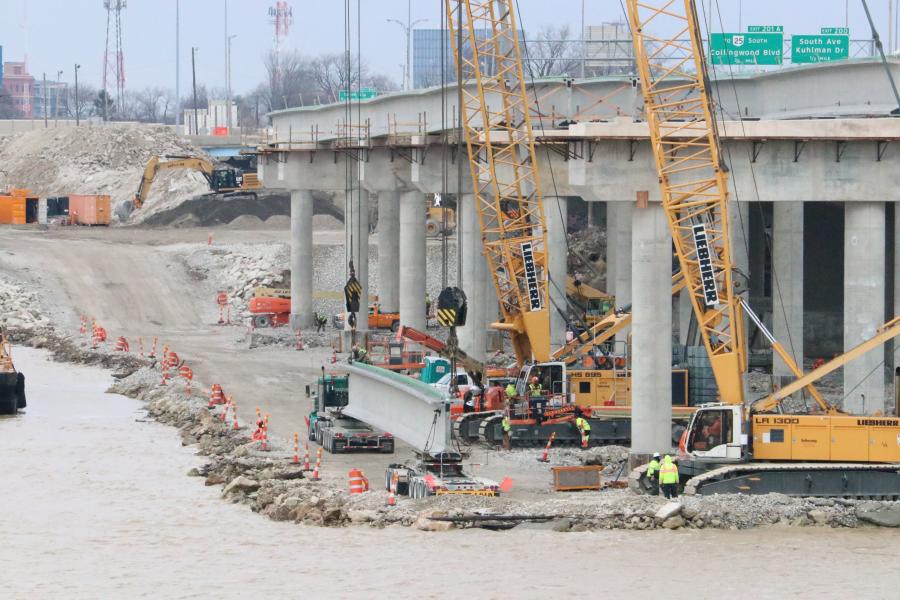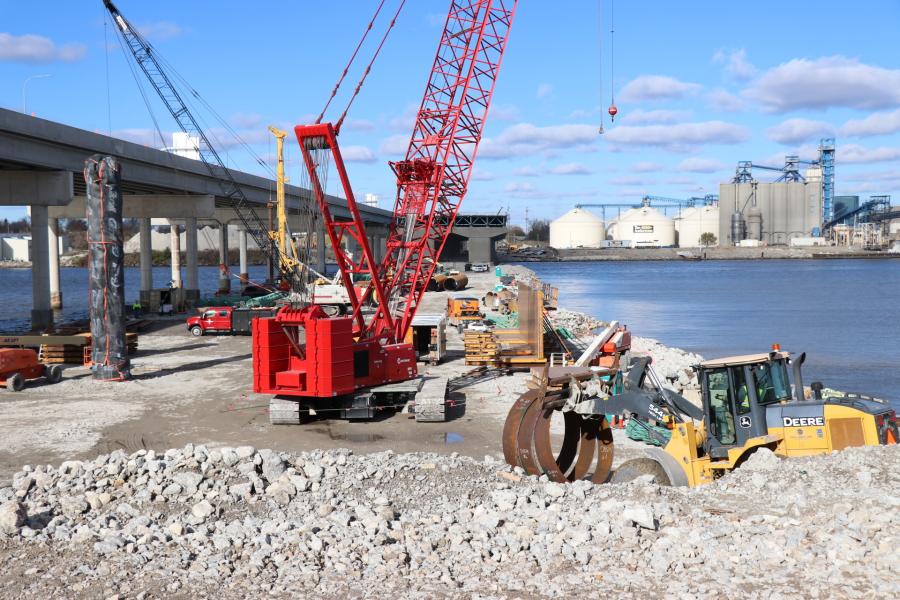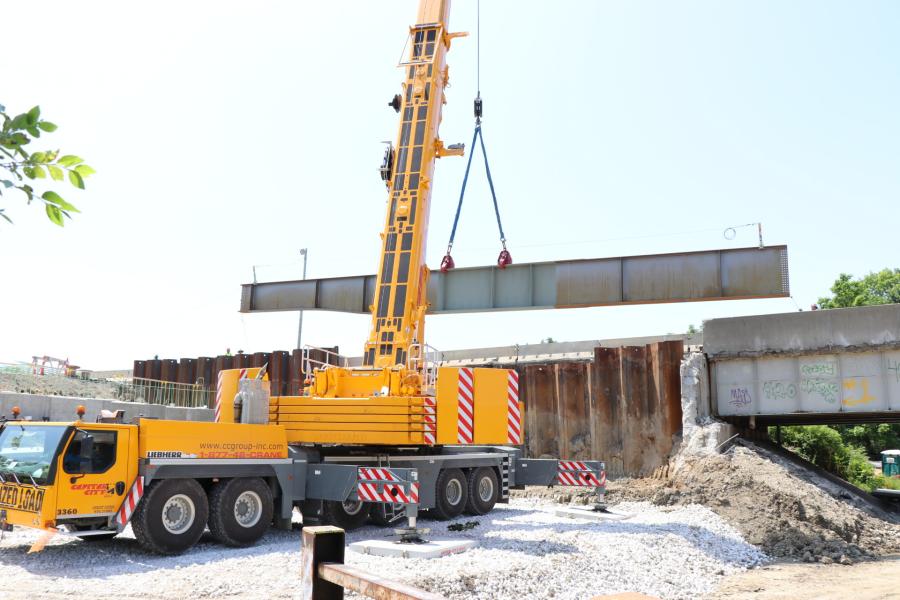The Ohio Department of Transportation (ODOT) is overseeing separate projects in Wood and Lucas counties which includes I-75 widening, reconstruction and bridge replacement at a total cost of $352 million.
(Rebecca Dangelo photo)
The Ohio Department of Transportation (ODOT) is overseeing separate projects in Wood and Lucas counties which includes I-75 widening, reconstruction and bridge replacement at a total cost of $352 million. The north project is in downtown Toledo, between South Avenue and Dorr Street, with the south project taking place between Buck Road and South Avenue. It includes the Michael DiSalle bridge. Work on the projects began in 2018.
"I-75 has a significant curve between Wales Road and the Maumee River, which has led to several accidents in the past," said Mike Benton, ODOT project engineer. "This didn't quite meet our current geometric standard, so the curve needed to be lessened. Also, several of the bridges need rehabilitation or reconstruction."
Kokosing Construction Company is the prime contractor for the Wood-Lucas County section.
"Kokosing has always proved to be an innovative contractor," said Benton. "This has helped with some of the complex work items, including the reconstruction and demolition of the Disalle Bridge over the Maumee River. They also have numerous resources, including a large equipment fleet; their own material division for aggregates and asphalt; and personnel with experience on high-profile projects.
"The contractor submitted, and ODOT eventually accepted, one of the largest Value Engineering Change Proposals [VECP] in ODOT history. This included changing the northbound Miami Street entrance ramp that was to be part of a diamond configuration into a trumpet configuration. This reduced the amount of work in an area with poor soils and eliminated a ramp bridge."
The biggest challenge on this project involved poor soil conditions, particularly in the area between Miami Street and the Maumee River.
"In the past, this area was used as a waste site for a byproduct of the glass manufacturing process called ‘rouge,'" said Benton. "This was a unique material that was very stiff, with a high compressive strength in its undisturbed state. However, once disturbed it could turn into a semi-liquid state quickly. This led to ODOT utilizing ground improvement techniques that had never been used on ODOT projects.
"The work consisted of installing a series of controlled modulus columns [CMCs] that were designed by the contractor. The big challenge was that the material didn't turn into the semi-liquid state as often as the contractor anticipated, which made the installation more difficult.
The main item of work is setting beams on the new northbound Disalle Bridge and prepping for deck pours. Ground improvement work is beginning on the north side of the river. This will lead into construction of a large MSE wall and significant amount of embankment placement for proposed NB I-75.
Due to the realignment of I-75, three pairs of bridges will be torn down during construction.
"To date, the existing southbound bridge over Miami Street and a majority of the existing Disalle Bridge has been demolished. The NB and SB I-75 bridges between Wales Road and Miami Street over CSX RR, the NB I-75 bridge over Miami Street and the remainder of the NB and SB Disalle Bridge over the Maumee River have yet to be demolished."
Site work has included 320,000 cu. yds. of excavation; 560,000 cu. yds. of roadway embankment; 150,000 tons of asphalt pavement; and 45,000 sq. yds. of concrete pavement.
"For the I-75 section from Buck Road to South Avenue, the significant improvement necessary to meet current standards was lessening the curve between Wales Road and the Maumee River," said Benton. "This area of roadway no longer met our geometric standards. In addition, there were various entrance ramps that didn't meet current sight distance and merge distance standards.
Crews also are tasked with reconfiguring I-75 interchanges with Anthony Wayne Trail, South Avenue and Miami Street.
"A significant improvement for the Miami Street and South Avenue interchanges is that they will be connected in both directions via add/drop lanes on the proposed Disalle Bridge. Merge distances were an issue with both interchanges, and this will greatly improve that. All South Avenue ramps will be reconstructed, but only one will undergo a significant reconfiguration.
"The existing SB I-75 entrance ramp from South Avenue entered I-75 at a sharp angle and had a very short merge distance. The entry angle will be greatly improved, which will help sight distance and the add/drop lane will fix the short merge issue. The Miami Street interchange was to be reconfigured from a partial clover leaf to a diamond interchange per the original plans. However, the VECP will make the NB Miami Street ramps into a trumpet configuration."
Replacing the I-75 DiSalle Bridge over the Maumee River is no small endeavor, according to Benton.
"The proposed southbound Disalle Bridge was able to be constructed offline while I-75 traffic remained on the existing bridge. The contractor worked off a stone causeway placed in the river to construct the new bridge. The proposed southbound roadway and bridges are wide enough to support two lanes of I-75 traffic in both directions.
"So, once the southbound bridge and southbound pavement were complete, all traffic was shifted to the proposed southbound roadway. Demolition then commenced on the existing Disalle Bridge. Once demolition progressed far enough, the contractor began construction of the south end of the proposed northbound bridge."
Key tasks remaining include the northbound roadway north of Wales Road and all the proposed northbound bridges that need to be built.
"In addition, the northbound and southbound bridges between Wales and Miami, the northbound I-75 bridge over Miami and the remainder of the existing Disalle Bridge all need to be demolished. Also, there is an area north of the river with a significant amount of fill to place along with a sizable MSE wall to construct."
Main equipment on this project includes Cat 745 off-road trucks; excavators ranging from Cat 308 to Komatsu PC 1250; John Deere 624 and 644 loaders; a Cat 14G grader with GPS/UTS; dozers: a John Deere 450 and a Cat 6N with GPS; various cranes including a Grove 50 TN RT; a Manitowoc 80 TN; a Liebherr HS 895 HD; a Manitowoc 999; a Liebherr LR 1300; a barge; a tugboat; a CMC drill; and grout pump.
As for main materials, "The roadway pavement buildup on this project consists of asphalt," said Benton. "Also, there are five pairs of bridges on this project, so there is a significant amount of concrete being utilized on the job. These are the main materials being used, along with aggregates for roadway and the temporary causeway in the river."
For ODOT project engineer Kyle Ruedel, the north project in downtown Toledo, between South Avenue and Dorr Street, is equally demanding.
"The IR-75 bridge through downtown Toledo over Erie Street/Collingwood/Swan Creek/Anthony Wayne Trail is a very complex structure. This structure is in a curved section of highway, is more than 1,800 feet long and has entrance and exit ramps tie into the structures. Between the traffic requirements for below streets, waterway restrictions, curve, superelevation and ramp tie-ins, the construction of the structure takes particular care and expertise."
Said Ruedel, "IR-75 over Norfolk Southern Railroad [NSRR] was a challenge. The NSRR bridge was over two main NSRR lines, as well as immediately adjacent an Amtrak station running four trains a day and a NSRR maintenance yard. Norfolk Southern, through early communication, told the project team the seasonal window from Thanksgiving to Christmas would be the busiest time of year, with more than 75 trains a day, and that any track outages shouldn't be expected during this time frame.
"Additionally, the four daily Amtrak trains ran between 11:30 p.m. and 6:30 a.m. however, the exact times couldn't be guaranteed, and stoppages of the Amtrak line weren't permitted even if the train was not on time. To set girders over the railroad for this bridge during the second stage of construction, ODOT took the highly irregular step of allowing the contractor daytime stoppages of IR-75 to deliver steel girders and place them during non-peak railroad hours to avoid Amtrak conflicts. The permitting of daytime restrictions on IR-75 required months of planning."
Work currently taking place includes construction of the second stage of IR-75 over Erie/Collingwood/Swan Creek/Anthony Wayne Trail, as well as construction of ramp bridges between Anthony Wayne Trail and IR-75. Spring work will include the closure and reconstruction of the southbound 75 exit ramp to Washington/Indiana, a main downtown access for southbound 75 traffic.
The structure IR-75 over NSRR has already been completed, along with structure IR-75 over Segur Avenue. Reconstruction of Anthony Wayne Trail northbound and southbound between City Park and downtown also has been finished. In total, the downtown Toledo project has demolished 10 structures, all by mechanical means.
Regarding site work, specifically along the Anthony Wayne Trail corridor, the project has worked through unique circumstances related to the legacy of the existence of a canal system and warehousing near downtown Toledo within what is now project limits.
"While many of the warehouses, railroad yards and canal system are no longer in existence, the remnants and impacts remained to be addressed by the project.
"The reconstruction of Nebraska Avenue eliminated several spans that were over railroad tracks [that no longer existed] for a storage yard; several hundred feet of buried railroad lines were to be removed by the project. Also, the proximity of the project to Swan Creek and the Maumee River meant that an old canal system was within project limits. While buried and not specifically an issue in a few spots, drainage to be installed by the project encountered portions of the buried canal."
Ruedel said northwest Ohio's history as the Black Swamp means excavation typically includes a lacustrine clay soil.
"Due to the silt in the soil in the area, the project excavation is affected by rain once the soil is exposed. This can provide an additional challenge to the contractor when the material is needed to balance excavation/embankment within the project site."
The key improvement of the Anthony Wayne Trail interchange will be the elimination of the left side merges.
Both entrances from southbound Anthony Wayne Trail to south IR-75 and northbound Anthony Wayne Trail to north IR-75 had existing left side merges. Also, the exit from northbound IR-75 to northbound Anthony Wayne Trail had a left-hand merge into downtown, which will be reconfigured to a right-side merge.
Dirt and materials moved during construction include 235,538 cu. yds. of excavation; 199,883 cu. yds. of embankment; and 8,126 cu. yds. of granular embankment.
As for unexpected issues, said Ruedel, "Contractor access between Segur Avenue and South Avenue during phase construction was a significant issue. This area was the project limit interface between both projects, the phasing of both projects cut off access between South Avenue and Segur Avenue within project limits. ODOT partnered with the city of Toledo to gain haul road access on two residential city streets directly abutting IR-75. ODOT and the contractor looked at various options including mainline ingress/egress and staggered phasing, but these options presented significant safety concerns and/or project delays and costs."
North project equipment includes, but is not limited to, Link-Belt cranes; Cat excavators; Cat telehandlers; JLG boom lifts; a Lincoln welder; and a Genie manlift. Materials include structural steel (21,498,844 lbs.); reinforcing steel (6,684,894 lbs.); structural concrete (31,934 cu. yds.); asphalt (55,105 cu. yds.); and concrete pavement (6,560 cu. yds.).
Ruedel said despite the challenges, working on a project that will serve so many for years to come is rewarding.
"A project of this nature is truly generational. This is evident by the lifespan of the existing structures having been built in the 1960s and lasting for nearly 60 years. ODOT has strategically upgraded the regional IR-75 corridor beginning in 2014 with the current two projects being the final sections of the original IR-75 corridor upgrade. The safety benefits of the previously completed sections has already become evident."
All construction is expected to be completed by summer 2023. CEG
Cindy Riley
Birmingham, Ala., native Cindy RIley originally planned on a career in law, but during her sophomore year in college realized journalism was her true calling. A magna cum laude graduate of Samford University, Riley first worked in radio and TV. Named Best News Anchor, Best News Reporter and Best Investigative Reporter by the Associated Press, she interviewed numerous personalities, ranging from Dr. Henry Kissinger and President Bush to Michael Jordan and Captain Kangaroo.
As a print journalist, Riley has covered a variety of topics, including construction, business, health and the arts. In addition to CEG, her work has appeared in special reports for USA Today and the L.A. Times. Other publications have included New South Magazine, Portico, Thicket, Alabama Heritage, B-Metro, Business First and Birmingham Business Journal.
Read more from Cindy Riley here.
Today's top stories






















